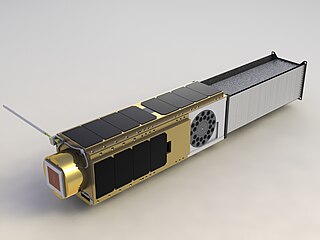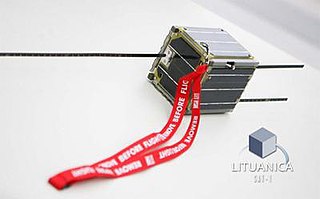
A CubeSat is a class of small satellite with a form factor of 10 cm (3.9 in) cubes. CubeSats have a mass of no more than 2 kg (4.4 lb) per unit, and often use commercial off-the-shelf (COTS) components for their electronics and structure. CubeSats are deployed into orbit from the International Space Station, or launched as secondary payloads on a launch vehicle. As of December 2023, more than 2,300 CubeSats have been launched.

The O/OREOS is a NASA automated CubeSat nanosatellite laboratory approximately the size of a loaf of bread that contains two separate astrobiology experiments on board. Developed by the Small Spacecraft Division at NASA Ames Research Center, the spacecraft was successfully launched as a secondary payload on STP-S26 led by the Space Test Program of the United States Air Force on a Minotaur IV launch vehicle from Kodiak Island, Alaska on 20 November 2010, at 01:25:00 UTC.
ITUpSAT1, short for Istanbul Technical University picoSatellite-1, is a single CubeSat built by the Faculty of Aeronautics and Astronautics at the Istanbul Technical University. It was launched on 23 September 2009 atop a PSLV-C14 satellite launch vehicle from Satish Dhawan Space Centre, Sriharikota, Andhra Pradesh in India, and became the first Turkish university satellite to orbit the Earth. It was expected to have a minimum of six-month life term, but it is still functioning for over two years. It is a picosatellite with side lengths of 10 centimetres (3.9 in) and a mass of 0.990 kilograms (2.18 lb).
SSETI Express was the first spacecraft to be designed and built by European students and was launched by the European Space Agency. SSETI Express is a small spacecraft, similar in size and shape to a washing machine. On board the student-built spacecraft were three CubeSat picosatellites, extremely small satellites weighing around one kg each. These were deployed one hour and forty minutes after launch. Twenty-one university groups, working from locations spread across Europe and with very different cultural backgrounds, worked together via the internet to jointly create the satellite. The expected lifetime of the mission was planned to be 2 months. SSETI Express encountered an unusually fast mission development: less than 18 months from kick-off in January 2004 to flight-readiness.

Chasqui I is a one-kilogram nanosatellite developed by students at Peru's National University of Engineering (UNI) based on CubeSat technology. Developed with assistance from the Russian Southwest State University (SWSU), Kursk, it was part of an educational project to acquire the experience and ability in developing satellites.

Radio Aurora Explorer (RAX) is the first National Science Foundation sponsored CubeSat mission. The RAX mission is a joint effort between SRI International in Menlo Park, California and the University of Michigan in Ann Arbor, Michigan. The chief scientist at SRI International, Dr. Hasan Bahcivan, led his team at SRI to develop the payload while the chief engineer, Dr. James Cutler, led a team of students to develop the satellite bus in the Michigan Exploration Laboratory. There are currently two satellites in the RAX mission.

RAX-2 is a CubeSat satellite built as a collaboration between SRI International and students at the University of Michigan College of Engineering. It is the second spacecraft in the RAX mission. The RAX-1 mission ended after approximately two months of operation due to a gradual degradation of the solar panels that ultimately resulted in a loss of power. RAX team members applied the lessons learned from RAX-1 to the design of a second flight unit, RAX-2, which performs the same mission concept of RAX-1 with improved bus performance and additional operational modes. Science measurements are enhanced through interactive experiments with high power ionospheric heaters where FAI will be generated on demand.

Colorado Student Space Weather Experiment (CSSWE) was the sixth National Science Foundation sponsored CubeSat mission. It was built by students at the University of Colorado at Boulder with advising from professionals at the Laboratory for Atmospheric and Space Physics. The CSSWE mission was a joint effort by the University of Colorado's Department of Aerospace Engineering Sciences and Laboratory for Atmospheric and Space Physics. The mission principal investigator was Prof. Xinlin Li, and the Co-PIs are Prof. Scott Palo and Dr. Shri Kanekal. The project manager for the project was Dr. Lauren Blum, the system engineer was Dr. David Gerhardt, and the instrument scientist was Dr. Quintin Schiller.
Technology Education Satellite (TechEdSat) is a successful nano-sat flight series conducted from the NASA Ames Research Center in collaboration with numerous universities. While one of the principal aims has been to introduce young professionals and university students to the practical realm of developing space flight hardware, considerable innovations have been introduced. In addition, this evolving flight platform has tested concepts for Low Earth Orbit (LEO) sample return, as well as planetary nano-sat class mission concepts.

AAUSat-3,, is the third CubeSat built and operated by students from the Aalborg University in Denmark. It was launched on 25 February 2013 from the Satish Dhawan Space Centre in India on a Polar Satellite Launch Vehicle (PSLV) launch vehicle (PSLV-C20). AAUSat-3 carries two Automatic Identification System receivers as the main payload.

PhoneSat is an ongoing NASA project of building nanosatellites using unmodified consumer-grade off-the-shelf smartphones and Arduino platform and launching them into Low Earth Orbit. This project is part of NASA's Small Spacecraft Technology Program and was started in 2009 at NASA Ames Research Center.

LituanicaSAT-1 was one of the first two Lithuanian satellites. It was launched along with the second Cygnus spacecraft and 28 Flock-1 CubeSats aboard an Antares 120 carrier rocket flying from Pad 0B at the Mid-Atlantic Regional Spaceport on Wallops Island to the International Space Station. The launch was scheduled to occur in December 2013, but later was rescheduled to 9 January 2014 and occurred then. The satellite was broadcasting greetings of Lithuanian president, Mrs. Dalia Grybauskaitė. The satellite was deployed from the International Space Station via the NanoRacks CubeSat Deployer on February 28, 2014. All LituanicaSAT-1 subsystems have been turned on, tested and proved to be working properly. The mission is considered a complete success by its team of engineers. The mission ended upon the reentry and disintegration of the satellite on July 28, 2014.

NUTS-1 was a Norwegian 2U CubeSat created by the NUTS student satellite project at the Norwegian University of Science and Technology (NTNU). The satellite was developed by students from several engineering and science disciplines. It was one of three CubeSats part of the Norwegian student space program ANSAT, the other two are the CubeStar and the HiNCube. From NTNUs CubeSat projects NUTS-1 is a successor of the nCube-1 and nCube-2 projects. The mission was stopped, and the small satellite activities are continued by the Orbit NTNU student organization and the HYPSO mission from NTNU Small Satellite Lab.
Space Tethered Autonomous Robotic Satellite II or STARS-II, was a nanosatellite built by Japan's Kagawa University to test an electrodynamic tether in low Earth orbit, a follow-on to the STARS mission.

The Nanoracks CubeSat Deployer (NRCSD) is a device to deploy CubeSats into orbit from the International Space Station (ISS).

Swayam is a 1-U picosatellite (CubeSat) developed by the undergraduate students of College of Engineering, Pune. They have successfully completed assembly of the flight model having a size of 1-U and weight of 990 grams under the guidance of Indian Space Research Organisation (ISRO) in January 2015. The structural design of the satellite, design of its electronic and control systems as well as the manufacturing of the satellite was carried out by the students. The project was completed over a span of 8 years and more than 200 students worked on it. The Satellite was launched by ISRO on June 22, 2016, along with Cartosat-2C by Polar Satellite Launch Vehicle C-34 from the second launch pad at Satish Dhawan Space Center, Sriharikota, India. The satellite is to be placed in low Earth orbit (LEO) around Earth at a height of 515 km.

Mars Cube One was a Mars flyby mission launched on 5 May 2018 alongside NASA's InSight Mars lander. It consisted of two nanospacecraft, MarCO-A and MarCO-B, that provided real-time communications to Earth for InSight during its entry, descent, and landing (EDL) on 26 November 2018 - when InSight was out of line of sight from the Earth. Both spacecraft were 6U CubeSats designed to test miniaturized communications and navigation technologies. These were the first CubeSats to operate beyond Earth orbit, and aside from telecommunications they also tested CubeSats' endurance in deep space. On 5 February 2019, NASA reported that both the CubeSats had gone silent by 5 January 2019, and are unlikely to be heard from again. In August 2019, the CubeSats were honored for their role in the successful landing of the InSight lander on Mars.

Earth Escape Explorer (CU-E3) is a nanosatellite of the 6U CubeSat format that will demonstrate long-distance communications while in heliocentric orbit.

OPTOS was a Spanish nanosatellite designed and developed by INTA with support from the European Cooperation for Space Standardization (ECSS) as a low-cost technology demonstrator. It was launched in 2013 and had a service life of three years.

GASPACS was a NASA sponsored 1U CubeSat developed entirely by undergraduate members of Utah State University's Get Away Special (GAS) team. The primary mission objective of GASPACS was to deploy a 1-meter inflatable aerodynamic boom to passively stabilize its attitude. GASPACS was the world's first CubeSat to be developed entirely by undergraduate students, and was also the world's first CubeSat to utilize a Raspberry Pi Zero as its flight computer.

















